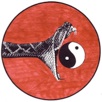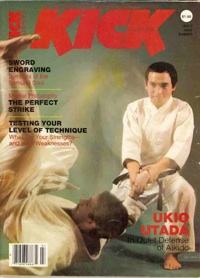
MONSTERMARTIALARTS.COM
The Source of the True Art!
THE PERFECT STRIKE

Webster defines philosophy as the ‘theory or logical analysis of the principles underlying conduct, thought, knowledge, and the nature of the universe.’ Included in philosophy are ethics, aesthetics, logic, epistemology (the study of the origin, nature and limits of knowledge), metaphysics (study of the nature of being or reality), and so on. Put simply, philosophy is the general principles of laws of a field of knowledge’
The martial arts, more so than many other activities because it deals with life and death, is an endeavor rich in principles relating to human morals, character and behavior. Indeed, philosophy exerts a great deal of influence on the martial arts of both today and yesterday.
The perfect strike is that blow which imparts energy most efficiently. As such, it is not dependent on factors such as muscles, size, bulk or speed. It is strictly dependent upon the ability to transfer the maximum amount of potential energy from one body to another.
This raises an important point, namely, ‘What is energy?’ Definitions of the term abound in the martial arts, ranging from the cosmic to the invisible. Since all the arts deal directly with energy, it should not be surprising that so many different interpretations exist. However, to simplify matters, let us consider the dictionary, which offers the following definition of energy: ‘the capacity for work.’ Simple as this may seem, upon reflection it appears obvious that this covers the spectrum of the question, ‘What is energy?’
This raises a second essential question, ‘What is the proper transmission of energy?’ An example will serve. Have you ever seen the row of steel balls hanging from threads? If the ball on one end of the line is swung to collide with the others, only a single ball on the opposing end will be moved. This is an example of the proper transmission of energy--the type of efficiency we should strive for in the martial arts.
Two major problems impede the perfect strike, emphasis on muscular exertion and problems of focus. Energy dependent merely on the muscles is energy locked within the body. When striking an opponent, energy flows into the muscles, but does not continue from there. It remains trapped within the body. In this case, energy is not transmitted to a target and beyond, rather, it remains caged. Energy focus is a problem in the frequently the energy of a strike is dissipated or prematurely delivered at the point of attack. As a result, the energy employed is contained at the point of focus and is not transmitted beyond that point.
There are a number of solutions to these problems. Two major ones are bagwork, which allows the artist to observe the effect of this strike and the transmission of energy; the other is in practicing breaking techniques. The drawback to these two approaches is the possibility that the martial artist may become obsessed with power. Bagwork is particularly susceptible to this problem. Breaking techniques, if practiced, must be practiced with a proper focus to ensure that proper transmission of energy occurs as opposed merely to the hand ‘going through’ the target.
The other drawback to both breaking and bagwork techniques is that neither feels like a human body. The problem of what it is actually like to strike a human body raises another central point. Take a door as an analogy. Walk up to the door and knock on it. Then open it, then touch it. Feel which technique creates the best sound. All you have to do is listen and try to get the largest sound with the least damage or work.
The body is pliable, rubbery in a sense. Try rapping on it as you would a door. Feel what is going on inside a person’s chest. This can be done without causing harm. You will still be able to sense the type of force and impact that creates the most effective sound or vibration in the chest. This is transmission of energy. You’ll find your knuckles don’t need to be tense and that neither size, bulk, nor speed are necessary factors in delivering a sharp rap. Technique and attention to detail are, however.
Having covered the problem that prevent delivery of the perfect strike, let’s examine blows that transmit their force imperfectly.
Too often individuals maintain rigidity beyond the point of focus in their strikes. This causes energy to shock up the arm. A leading cause of the problem stems from tension over the act of delivering a blow to another human body--a reaction that’s not hard to fathom. Still, this causes the arm to become a shock ‘absorber’--and energy is dissipated.
Now consider the way of delivering the perfect strike. Envision your arm as a tube--material surrounding the void. The ‘emptier’ the arm becomes--that is, more tube-like--the greater the ease for the energy of a strike to flow through, and beyond, the arm or leg or weapon extension.
Do not fall prey to the belief that the larger the arm, the larger the amount of energy to flow through it. It is not size, or pumping muscles that will cause energy to flow into a perfect strike, it is the ‘emptiness,’ the space you have envisioned in your arm. And this, in turn, depends on the amount of relaxation you are capable of.
But, to get back to the idea of an arm that’s empty--or full--of space, consider this: how much water can you pour into a full cup? How much water can you pour into a cup that is empty? What holds true for water can hold true for energy. If the arm is ‘empty,’ great is the amount of energy that can flow through it. If the arm is cramped and clogged with the energy exertion of muscles or speed and bulk--less energy will be conveyed in the strikes. The heart of the matter is an interesting twist on the old expression, ‘Empty your cup,’ and a commentary on karate, literally translates as ‘empty hands.’
Yet, what does the perfect strike feel like? Again, an old saying expresses it well: ‘the perfect art cannot be felt.’ And, when one executes the perfect strike--it cannot be felt. This is not as mysterious as it sounds.
Energy in the perfect strike, you see, flows in one direction. Nothing shocks back up the arm--including sensation. (Some of my students have reported a ‘rushing’ sensation, so this may not be true of all.) Yet if the flow of energy is perfectly transmitted the force, the energy, flows away without looking back. This would be the physical side of what a mystic would label ‘letting go.’ There is no effort, no striving, nor anything else.
There is, of course, the ultimate misfortune to the perfect strike. One cannot practice it full form with a partner, for the effect is too great. The few times I have connected with a perfect strike, I had the sensation of having missed, or that the blow was inches away from my partner--yet my partner fell instantly. I’ll make no excuses for my control--but it serves to illustrate a valuable point of reference in practicing the perfect strike. I hope this makes your pursuit of the perfect strike a little easier all the way around.
This article appeared in the July 1982 Kick Illustrated.


MENU
RESOURCES
PACKAGES
COURSES
MORE STUFF